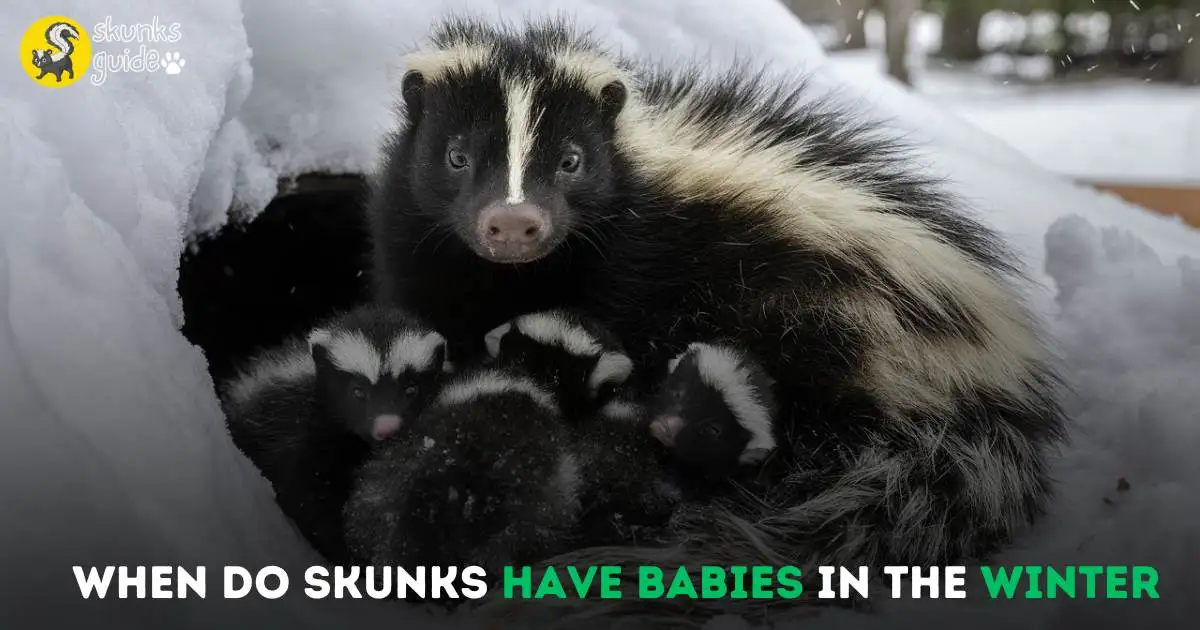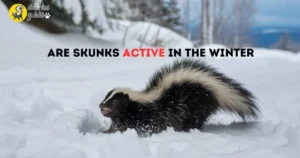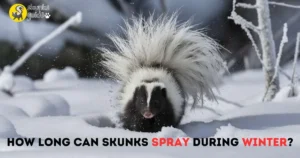When Do Skunks Have Babies? Key Mating Facts
Skunks typically do not have babies in winter. Their breeding season occurs in late winter to early spring. Their breeding habits and reproductive cycles are often a mystery, especially during the cold winter months. In this article, we’ll look into when skunks have babies in the winter and the details of their breeding behaviors.
Understanding Skunk Breeding Habits
Skunks, known for their black-and-white stripes, have an interesting way of breeding. The skunk mating season happens in late winter or early spring. They look for territories and mates during this time.
Mating Season and Gestation Period
After mating, the female skunk is pregnant for about 60-75 days. Then, she gives birth to a litter of young. This timing means the babies are born in spring when food is plentiful and it’s not too cold.
Factors Influencing Breeding Cycles
Many things can change how skunks breed, like where they live, the weather, and how much food there is. In colder places, skunks might breed at different times than in warmer areas. Also, how much food they have can affect when they have babies.
“Understanding the intricate details of skunk breeding habits is key to coexisting peacefully with these unique animals.”
Learning about skunk breeding helps us live with them better. It shows us how to appreciate and manage these interesting animals in our areas.
Do Skunks Give Birth in Winter?
Skunks do not give birth in winter, despite their winter activity and unique look. Their breeding and birthing happen as winter turns into spring.

The idea that skunks give birth in winter is wrong. They mate in late winter or early spring. But, they deliver their young between March and May, a few months later.
This delay is because skunks have a 2 to 3-month gestation period. By the time they are ready to give birth, winter is ending and spring is starting. Spring brings milder weather and more food.
“Skunks are well-adapted to their environments, and their breeding cycles are timed to ensure the best chance of survival for their young,” explains wildlife biologist Dr. Emily Walton.
Skunk babies arrive in spring, when their main food sources like insects and small rodents are available. This timing helps the young skunks get the resources they need to grow.
| Mating Season | Gestation Period | Birth Timing |
|---|---|---|
| Late Winter/Early Spring | 2-3 months | March-May |
Skunks are active in winter but their birthing cycle starts in spring. This ensures their young have the best start. Knowing about skunk birth timing helps us appreciate these creatures more.
Preparing for Skunk Babies in Spring
As spring comes, female skunks start to prepare dens for their babies. These dens are where they will give birth and care for their young. Knowing about skunk denning and skunk nesting helps people live with skunks peacefully.
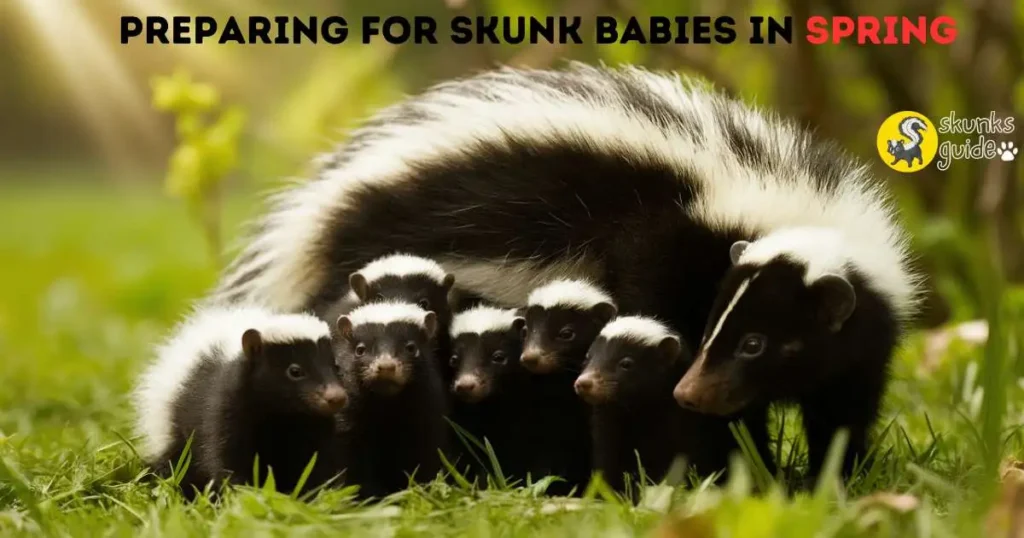
Denning and Nesting Behaviors
Skunks look for different places to den, like old burrows, piles of brush, or even under buildings. Once they find a spot, they collect materials like leaves and grass. They use these to make a safe place for their babies.
Caring for Newborn Skunks
After the babies are born, usually in late spring or early summer, the mother skunk takes care of them. She feeds and cleans them and teaches them important survival skills. The babies stay with her for several months, learning and getting bigger, before they leave.
Knowing how skunks behave helps people and skunks live together better. It also helps prevent problems, like keeping trash cans closed and not disturbing dens. This way, everyone can have peaceful encounters with skunks in the spring.
When Do Skunks Have Babies in the Winter?
Skunks don’t have babies in the winter. They usually have their young in the spring, from March to May. This is because their mating season and gestation period fall during this time.
The winter weather isn’t good for newborn skunks. They need a safe place to grow, and the cold and less food make it hard for the mother skunk to care for them.
Skunks mate in late winter or early spring. After about 2 months, the babies are born. This is when the weather is warmer and there’s plenty of food, helping the family survive.
| Skunk Breeding Cycle | Timing |
|---|---|
| Mating Season | Late Winter/Early Spring |
| Gestation Period | Approximately 2 Months |
| Birth of Skunk Babies | March – May |
Skunks are active in winter but breed and give birth in spring. This timing helps their babies have a better chance to survive and grow in the warmer months.
Skunk Reproduction in Different Regions
Skunks breed and give birth in similar ways across their range, but there are some differences based on where they live and the climate. The timing of mating and birth can change with latitude and elevation. Skunks in the north or at high elevations might have their babies a bit later in spring.
Geographical Variations
Skunks live in many places, from the eastern U.S. forests to the Southwest deserts. This variety in geography and climate leads to differences in skunk breeding habits by region and skunk reproduction in different climates.
| Region | Mating Season | Birth Timing |
|---|---|---|
| Northeast | Late February to March | Early May |
| Southeast | January to February | Late April |
| Midwest | Late February to March | Early to mid-May |
| Southwest | January to February | Late April to early May |
| Pacific Northwest | Late February to March | Early to mid-May |
The table shows that skunk mating and birthing times vary by region. Skunks in warmer, southern areas breed and have babies earlier. Those in cooler, northern places have a slightly later cycle.
“Understanding these regional differences in skunk reproduction can help wildlife professionals and homeowners better anticipate and prepare for the presence of skunk families in their area.”
Fascinating Facts About Skunk Babies
Skunk babies, also called kits, are amazing creatures with unique traits and behaviors. They have special characteristics and abilities that make them stand out. Their looks and how they defend themselves are just a few reasons why they are so interesting.
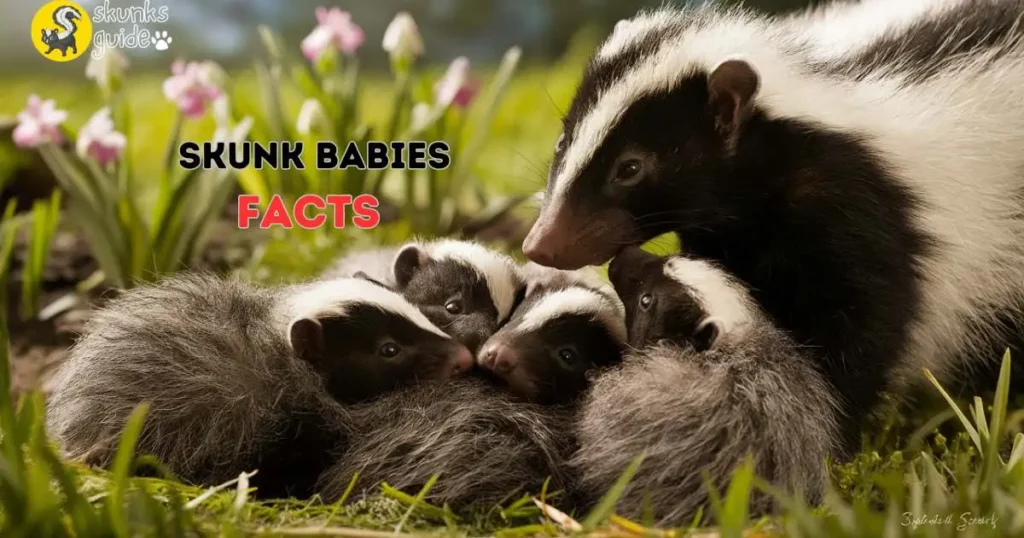
Unique Characteristics and Behaviors
Skunk kits are known for their black and white fur. This color warns predators to stay away. At birth, they have a gray coat that changes to black and white later on.
Skunk kits learn how to spray a strong-smelling liquid early on. They can do this as young as 10 days old. This skill is key to their survival.
- Skunk kits are born with a fluffy gray coat that gradually develops into the iconic black and white pattern
- Kits can start spraying as early as 10 days old, showing how vital this skill is
- Skunk kits are very curious and playful, often fighting in play to learn survival skills
Skunk kits are not just interesting because of their looks or smell. They are also very curious and playful. They have “play fights” to learn how to hunt and survive. This shows how smart and adaptable they are.
| Skunk Baby Characteristics | Skunk Baby Behaviors |
|---|---|
| Distinctive black and white fur | Ability to spray as early as 10 days old |
| Born with fluffy gray coat | Highly curious and playful |
| Gradual development of iconic pattern | Engaging in “play fights” |
Skunk kits are truly captivating with their looks and abilities. They teach us a lot about the natural world. By learning about their traits and behaviors, we can appreciate the diversity of nature more.
Frequently Asked Questions
How Long Does A Mother Skunk Stay With Her Baby?
A mother skunk typically stays with her babies for about 8 to 10 weeks. During this time, she cares for and teaches them essential survival skills. After weaning, the young skunks gradually become more independent but may stay close to their mother for some time.
Do Skunks Nest In The Same Place Every Year?
Skunks often return to the same nesting site each year. They prefer familiar locations that offer shelter and safety, and factors like food availability and disturbance can influence their nesting habits. Maintaining a consistent environment encourages them to return annually.
How Many Babies Does A Skunk Normally Have?
Skunks typically have 4 to 7 babies per litter. The gestation period lasts about 60 to 75 days. Baby skunks are born blind and helpless, relying on their mother for care and protection. They start to emerge from the den at around 8 to 10 weeks old.
Conclusion
Skunks don’t usually have babies in winter, but knowing how they breed is important. It helps people living where skunks are found. By understanding when they mate and how long they carry their babies, we can prepare for skunk babies in spring.
Knowing how to spot skunk signs like tracks and scat helps us live with skunks, even in winter. This knowledge, along with learning about skunk babies, makes us appreciate these animals more. It helps us get along better with nature.
Learning about skunk reproduction and their role in nature is key. It helps us have a better relationship with skunks, even when it’s cold. By understanding them, we can live with skunks in a way that’s good for everyone.

